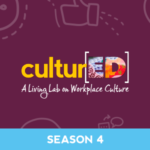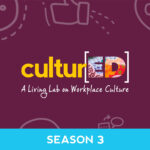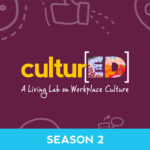
Melissa chats with Tess Hanson and Yağmur Halezeroğlu, the co-founders of Dance For All Bodies, about how their nonprofit is building accessible dance spaces in-person and virtually.
Melissa: Welcome to the cultur(ED) podcast. I’m Melissa Jezior, your host.
On this podcast, I have conversations with culture makers in the world today to unpack the visible and not so visible forces that make up this often-overlooked superpower of organizations. In season four of cultur(ED), we’ll be diving into a topic that more and more organizational leaders are paying close attention to. How to create more inclusive spaces.
We know that diversity, equity, and inclusion are a high priority issue for companies today. We’re seeing leaders investing in DE&I knowing that it is their responsibility to create meaningful change in spite of the history, often marginalizing underrepresented groups within the workplace but to be successful, it takes more than making a public statement supporting DE&I or hiring DE&I staff. It means a real commitment to creating an inclusive culture and inclusive spaces where employees feel valued, accepted, and willing to bring their whole self to their job.
Today, we’re delighted to have two guests with us from Dance For All Bodies (DFAB). I’ll have them introduce themselves.
1:09
Yağmur: Hi, this is Yağmur Halezeroğlu, I’m one of the co-founders and a board member currently.
Tess: And I’m Tess Hanson, another co-founder and the current Board President of Dance For All Bodies.
1:20
Melissa: Wonderful, well welcome, Yağmur and Tess. DFAB is a non-profit established in 2019 to address the problem of the limited availability of dance classes accessible to the disability community, especially for disabled adults. Their solution has been to organize online dance classes that prioritize inclusion and accessibility in multiple dance styles. Welcome Tess, and welcome Yağmur.
1:45
Yağmur and Tess: Thank you. We’re excited to be here.
Melissa: I’m excited to learn more about your stories. So first, maybe you can start there, tell me about how you both came together to start DFAB. I understand the origin was a one-time dance class that you organized for an amputee support group as a volunteer at the San Francisco Hospital and now your classes are primarily online, I understand. So anyway, tell me your story.
2:10
Yağmur: Yeah, of course. I’ll go ahead and get our story started. So, I was a volunteer at San Francisco General Hospital at the Orthopedic Trauma Institute, working primarily with amputees and individuals who recently had an amputation, or who have had an amputation for a long time.
My responsibility was to organize these monthly amputee support groups, and those had a wide range of topics from how to take care of your amputated limb, but after surgery to social, emotional, and financial supports. But for one of the support groups, people wanted something more creative and something more active. As a dancer, myself, I thought, we should do a dance class. That’s exactly what this group would appreciate and would like.
So. I reached out to one of the organizations in the Bay Area, called Axis Dance Company they organize physically integrated dance classes but they also perform a bunch of choreography, and do performances in the Bay Area, and internationally, with dancers who are disabled and dancers who are non-disabled. We reached out to them and one of the dancers from Axis Dance Company came into the hospital and taught a dance class. He was a wheelchair dancer. Itwas just a really impactful experience for our participants and something really eye opening for me, because I’ve never been in a physically integrated dance space. All the dance spaces looked like just what we always think about that are more able-bodied people participating in the dance class.
It was something totally new for me, and something totally new for our participants, too, because they haven’t danced since, or been creative in that way, since having their amputation and didn’t really get to explore that side of themselves.
4:09
After the dance class, they were already asking me when the next class would be, and they were in a totally different mood when they first came into the support group. So, I was like, “we need to do more of this.” I need to go with this idea and make it a reality. I was thinking about it for a long time and Tess and I are longtime friends, we worked together, and we just became really close friends, and I know Tess loves, dance, and cares about disability rights.
So, I shared this idea with Tess and then we got the non-profit started with just an idea and some shared passion for what we do.
4:48
Tess: I’ll add that before we got the non-profit started, we had to write an eight-page grant to our school asking for money, and we won second place in the innovation competition and that was where our seed funding came from. An important tidbit.
5:05
Melissa: Awesome! So, it sounds like you started off in the early days, with your classes being in person. My first question is, when you first started, how did you ensure the spaces that you had met the needs of your attendees, especially since it sounds like neither of you come from the background of working with disabled individuals. I’m curious, how did you figure that out? What did it look like? How did you make sure it really worked?
5:31
Tess: Yeah, I can start us off. For transparency, I’m not a disabled person. But one way that Yağmur and I really prioritized access in our classes was thinking about physical access. Physical access is the most probably familiar that most of our friends and family and communities are thinking about access, but it’s important to recognize that it’s not the only way to ensure access in any sort of event or class or space.
But in terms of physical access, things that we thought about were where is the studio relative to public transit because for a lot of physically disabled folks, and disabled people at large, moving through urban spaces moving transiting around is really difficult because not everybody can drive. So being close to public transit is an important piece of providing physical access. We also made sure that there was a route into the studio that didn’t involve stairs. Is there an elevator available? How big is the doorway? How navigable is this space if you’re not walking, because a lot of our first attendees were people who had just recently had amputations or were in wheelchairs or using a knee scooter. So, we had to think about how do people get around when they’re not walking?
6:50
Those are important things that we thought about when planning our dance classes for that in person element. Another thing – like a really simple way to provide access is to have someone meet and greet you at the door to the hospital. When we had classes in the hospital this is one room in a sea of like a huge infrastructural building with hallways so just having someone like myself to greet somebody and pass along information like, “you are going in the right direction,” or, “head this way.” Even that person providing the information, is a form of access too.
7:24
Melissa: You mentioned there are other types of access other than physical. So tell me a little bit more about what you mean by that.
Tess: Yeah, do you want to start Yağmur?
Yağmur: Access is such a broad term, right? And it can look and mean something different based on your access needs. It can be having a fragrance-free space. It can be having just a slower pace of the class. It can be giving options to do a dance movement in different ways. So instead of doing a movement with your arms, trying it with your torso, trying it with your legs or trying with your eyes. Just moving your eyes or your facial expressions. So, it can really look so many different way, and I think that’s the beauty of it and you can just take it whatever direction you want to.
Tess: I will add that in addition to all those things one way or another form of access is providing hearing access or language interpretation for hard of hearing participants and deaf participants. So, having an ASL interpreter is not physical access but that is an essential part of creating a space where people can be a part of the dance class if they don’t hear.
8:40
Melissa: , All those make sense. How did others respond to DFAB? What surprised you the most in terms of what others responded to you about your vision?
Tess: Anybody we talked to who was outside the disability and dance bubble gave us a huge thumbs up. They’re like, “you go,” “this is amazing,” and like, “go forth and make this happen. You two are very supportive, so much enthusiasm.” And then when we talk to people who were actually in this space, working between the disability community and the dance community trying to intersect these things, they sat us down and had to go, “OK, are you ready? It’s really hard to create change like this. If you want it – if you’re tenacious and you keep pushing, it will happen.” They sort of modulated our expectations.
9:35
Melissa: What does that mean? Like it’s hard or you’re tenacious? What were they expecting for you to come up against?
Yağmur: Well, I think it was a reality check in many ways. One reality check was in the way that Tess and I, we don’t have disabilities and we don’t identify as parts of the community. People really wanted to understand why we were doing this and if we’re actually in it for the right reasons. Because this is really difficult work and we’re coming in from a position of privilege doing this work and we have to learn and teach ourselves so much and understand the complexity of the world of disability. It was a humbling moment, I think, and a good moment to reflect on why we’re doing this and if we’re actually going to be able to accomplish what we want to.
I think it was also important to understand the financial challenges of building something for people with disabilities because of the limited amount of funding for projects like this that intersect dance, or arts, and disability, which is a totally underfunded area compared to any other project supporting people with disabilities. Disability has been medicalized so much that we immediately think of it and we say, “oh, we should put money, or funding, into treatments or care for people with disabilities but we don’t think about the creativity aspect of disability.
It’s an underfunded area, and that is, I think, constructive feedback that we got from people who have been working in this area that you have to really think about how you’re going to be funding this project. How you’re going to be turning this idea into reality and make it viable given the challenges of the funding space.
11:39
Melissa: That makes sense. One thing that resonates with me as I’m listening to you talk that I’m guessing a lot of our business leaders listening might relate to is that in the topic of inclusion, you’re always trying to learn about somebody else, right? You’re always trying to learn about what someone else needs and everybody looks different than yourself, so that resonates with me when you talk about coming in with from a place of privilege. You’re not part of the community but you’re trying to learn what that community needs.
Is there any advice you would have to business leaders who are trying to be more inclusive and what they need to do themselves in terms of learning about others to improve their own spaces or their own organizations?
Tess: I’ll speak from my experience, something that I tried to do when we were really in the very beginning of DFAB was I read a lot of disability related blogs written by disabled people. I tried to find resources that would teach me the language of the community because disability is a cultural identity that I’m not a part of, but I can learn. And I can learn to understand what people say when they mean things like, when a disabled person refers to themselves as a “crip” – like why is it OK for them to say that but not OK for me as a non-disabled person to say that?
Learning about language is always a really good first step. I think learning about disability history. When DFAB was starting to begin, the documentary Crip Camp came out on Netflix and that, I think, is a really good resource for anybody, any business leader, who is looking to more intentionally acknowledge and think about disabled people in our society and where they might fit in their business, too. So, I think the resources are out there. They’re definitely out there. You do have to dig. And it takes time too.
13:39
Yağmur: I’ll add that it’s always meaningful to show consistency in whatever you’re doing. If you’re there for a long time and you keep showing up and you keep coming in with a genuine sense of curiosity, then that’s really impactful.
13:55
Melissa: You were originally in person and now you’re online. Tell us about the process you use to design your classes today and how you moved from being physically class to being online classes.
Tess: Well, there was a little thing called Corona virus. So well we incorporated DFAB and became a non-profit in late 2019 and were organizing classes and then boom everything shutdown and we had to move virtually. And I think one of the first things we did (Yagmur let me know if I’m wrong) is we sent a survey to people, like, “do you want to do virtual dance classes?” And people said, “Yes.” So we said, “OK, we’re going to try it.” After that, we just didn’t stop. And one of the important things to note about doing online classes is though there are some unique challenges it really does make what we are offering more accessible. We can just reach so many more people. It meet disabled people where they are at, hopefully in the comfort of their home. And they can dance from their room; they don’t have to leave anywhere; they can turn the camera off if they are feeling a little more bashful.
It really helped us fulfill our mission and take it to a new level, a new scale. So COVID, in that sense was a relief but somehow became a positive for us in that regard.
15:23
Melissa: Have you gotten any feedback on people whether they miss the in-person classes?
Tess: I think they do. We have a pretty strong contingent in the Bay Area because that’s just where we began. And so a lot of people who do take our classes online are also friends with these people in real life. And I think they do miss the in-person because it’s really not the same. As good as DFAB is, it’s not the same. But now we have people all over the US. We have a teacher who’s based in Canada. I wonder, would it be like to somehow have an in-person class for all these people…maybe one day.
16:03
Melissa: So, right now no plans to go back to be in person, right? Or, maybe? One never knows. You’re flexible?
Tess: I think, I don’t know, I see us trying to navigate the hybrid line. I don’t think will ever fully be not virtual and because of just how we have grown and the way we have shaped ourselves, but I do think there’s desire for within the community, for an in-person presence, and I would like that too. It’s fun to mix with people.
16: 37
Melissa: Yeah, I think everyone’s finding that, right? This is why hybrid has become so popular, right? This is wonderful to be able to do Zoom or whatever it is, but there’s nothing quite like meeting someone in person, I think.
How do dancers or instructors without disabilities design classes for those with disabilities? Do they gather input from the folks who have disabilities? Like, what do they do?
Yağmur: Well, we mainly work with dancers with disabilities, though we still have some dancers without disabilities who teach our dance classes but we try our best to prioritize giving teaching opportunities for dancers with disabilities. In our organization, for our instructors without disabilities, we do have a couple of resources that we share with them and some tips. Some of them are just as simple as wearing solid colored clothing, explaining what they’re doing first, and then demonstrating it, giving image descriptions of themselves at the beginning of class, always identifying themselves when speaking. This is really useful for ASL interpreters.
We always encourage our instructors to provide movement options if they’re doing a movement with their right arm, where they lifting it high up, maybe also doing a movement where they lifting it halfway or doing something lower down and giving options for pacing of movements. So, we do have some resources and although we don’t do a really thorough teacher training for our instructors, we believe that they are really experienced instructors and they are in it for the right reasons. They’re curious and want to learn more. We just provide them with some tips and tricks for how to teach an accessible dance class and they adapt as they go, and they get feedback from the participants. We always do surveys after class and we always share those feedback with our instructors after class so they can adjust the way they’re teaching.
18:52
Melissa: We talked earlier a lot about access. One thing I’m just curious about, in terms of how does it create a barrier, is clothing. Oftentimes, when you think about dance, you think of leotards or ballet shoes and that in and of itself seems like it could be a barrier. So how does that impact you and your participants?
Tess: I’ll say that one of the beautiful things about DFAB is that there is no expectation around what you wear. Our classes are not designed to teach technique, necessarily. Technique might be a part of it, per the instructor’s design for the class, but the point and the ultimate goal of a DFAB class is to feel comfort and joy moving your body. And so there is no expectation that you need to wear a leotard and tights. We’re not trying to fit into that standard or that sort of ballet box.
We’re doing something that is different and on the other side – the far other end of that spectrum. And that’s OK. Both can exist at the same time and both are wonderful and they have their moments. I think that’s one reason why a lot of participants like to come to our class and that’s why we have a lot of adults who are in their forties and have never danced before but like our classes because you just show up and you enjoy moving with other people. The music is fun and our instructors are usually very enthusiastic and energetic. And it’s definitely more about community and self-expression and trying something new than it is about well, we got to make sure we look a certain way and we’re going to nail this technique. It’s much more open-ended.
20:50
Melissa: I definitely think there’s something there that the business world can learn from what you’re doing. There’s this big push right now to bring your whole self to work or can you bring your whole self to work? And so it sounds like you’ve figured out a way to say, “yes, bring your whole self to the class. Don’t worry about traditional dance.” Right, like you’re here – don’t worry about that, right? Bring yourself and you do you. So, do you feel like you’ve made any mistakes along the way? Were there any key learnings on how you would do things differently?
Yağmur: I think we’ve made many, many, many mistakes. And I really like this question because, especially when we were growing as a non-profit, well, it was the two of us. It was just Tess and I for a long time. And then on our transition to online we got a bunch of volunteers to join us. And at some point, we were just constantly all of us, we were making mistakes and wanted to acknowledge that and bring that into our weekly meetings where we highlighted a mistake we made that week and talk about what we’ve learned from it. I was just trying to normalize making mistakes, because I’ve found out that I was constantly making mistakes and learning from them.
Two examples that came to mind when I was thinking about this question, was one of them we wanted to work with this new instructor based in Germany who is a ballroom wheelchaired dancer. And he has been teaching for a long time, has been competing, and is really awesome. And I reached out to him, and he was really enthusiastic to teach a class as well. And I thought it would be a great addition to what we offered at DFAB. It was little different from what we offer; it was more technical. And so we decided to do a class but beforehand I didn’t really do a good job clarifying the expectations of it from a DFAB class and what our community usually wants and needs. So, I think the needs and expectations of the community didn’t match what was delivered in the class. And so I noticed that a lot of our participants were feeling frustrated during the class or a little disappointed because they came in looking for a DFAB like dance class but the dance class that this other instructor that we just recently partnered with he was focusing more on technique and just the style of teaching was a little different from our other instructors.
So that was a great learning point for me, that I really need to be clear on defining what DFAB’s dance classes are about and have a good communication with our instructors that we are initially just starting out with.
23:34
And then the other one was we gave a presentation with Tess and for this presentation, we had image descriptions on the slide describing what our instructors look like. And for one of the descriptions, we didn’t confirm the image description with the instructor who we were describing – their skin tone and their gender presentation. And when they saw that presentation, the image description didn’t really resonate with them. And this was also a learning point for us that we we need to have people define, or write, their own image descriptions and not assume things about people based on an image of them.
In a world where we are constantly thinking about access, and because we are a non-profit centering access, small things like this that might seem small, aren’t actually that small and we need to be really careful and thoughtful about how we move forward.
24:31
Melissa: Those are good examples, and I’m with you Yağmur – you got to be able to confront your mistakes and no better way to learn, even although it’s painful at times, right? There’s no more painful of a learning process than making the mistake, but it’s a great way to learn.
So, I understand you’re expanding, that’s exciting! Making programs available around the world. So, what do you look for? You just talked about this mistake you made when hiring someone, so maybe we can even elaborate on this. What do you look for when hiring people to support your vision and your value? What traits are you looking for in people who support inclusive cultures?
Tess: Part of our mission, and our reason of being, is to prioritize disabled leadership, because disabled people are the most impacted and centered in our work. So, one of the reasons we transitioned out of our executive Director role, is because we gave it to two disabled people to run the org because they have the lived experience and the cultural knowledge to help DFAB grow to the next level. So, we still value that and disabled people are represented in every facet of DFAB from the volunteers to paid staff to our community on our board. So, I think that will continue to be a priority in our expansion. And we also, in general, we look for people who are empathetic and curious, and it’s helpful if they have background knowledge in disability work, but it’s all learnable like I mentioned earlier. It’s all learnable, so if someone’s willing to learn that’s very valuable, too.
26:07
I think it’s important to also mention here that a lot of what we also want is dependability and commitment. It’s super helpful to have people, especially volunteers, because we do have a large pool of volunteers who make a lot of magical things happen for DFAB, we want people who are dependable and committed despite the lack of pay. And just want to mention that there is kind of an inherent ableism with that to expect a sort of high level of commitment for little pay because a lot of the volunteers we do work with, if they are chronically ill, or if they have a disability like that, it changes, what commitment looks like. Commitment for them looks different than what I would consider myself to showing commitment. So we have these desires, and we have sort of this ideal that we want, but part of our work in DFAB is being able to accommodate and figure out what everybody who is in the room can offer so that we get to where we want to be or as close as possible. So we have our vision for the ideal person we would hire but everybody has something to offer in some way, and if we work as a team usually it can get done.
Does that make sense?
Melissa: It does, absolutely. Yağmur do you have anything to add?
Yağmur: I think that was, that was perfect.
27:40
Melissa: In your journey, where have you found most of your support? I assume it takes a village, so tell us more about how this has expanded even beyond the two of you.
Tess: I think Yağmur and I both want to start with someone named Danny Bicknell, who helped us write the grant for DFAB that began the operation and she has been with us every step of the way as a mentor. She’s an amazing person, and so, just wanted to share her name. She has been an incredible, incredible source of support for us. Also, Bonnie Lewkowicz and Judy Smith, who are both founding members of Axis Dance Company and very active dancers in the disability community. Stephanie Bastos, who’s one of our early, early, early teachers who taught for us and we were a little more disorganized and weren’t really sure what we were doing but has been with us, through the whole thing.
Yağmur: I really want to highlight our early participants in our classes that we organized in 2018, actually, when we tried to get a sense of what the community needs and how we can best support them with our offerings. They really helped us shape what we do at DFAB and without their input and their support and guidance based on their lived experiences, we wouldn’t be able to organize or get DFAB to where it is right now. And also, I’ve mentioned how lovely our volunteers are but this is definitely not the support of two minds: Tess and my mind – it’s definitely a collective mind of the directors, of the volunteers, and the community members. We constantly try to get the inputs of our community members our dance class participants, so that we can shape the best dance class experience for them.
29:30
Melissa: Wonderful. If our listeners wanted to learn more about your organization, where can they go?
Yağmur: Yes, so they can go to DanceForAllBodies.org, or you can look up “Dance For All Bodies” on Instagram, Facebook, or YouTube. We’re everywhere! You can find more info about us. And if you want to support our mission, then you are also welcome to donate or be a sponsor. There is more information on that online on our website as well.
Tess: And we’ve also done a lot of one-off wellness informed classes for a lot of different businesses and non-profits. So, we would love to organize and bring some DFAB energy to your group if you’d like.
30:17
Melissa: So you also do work for businesses, Tess, why don’t you tell us a little bit more about that?
Tess: Yeah, So DFAB has had the pleasure working with a lot of different businesses in different fields. Some really small, some large corporations like Lowe’s or Ford, and what we do is we can organize an hour to an hour and a half class with one of our really skilled disabled dance instructors to teach a mid-day or sort of like dance break for your team and it’s really fun. It gets everybody up and moving to whatever degree they’re comfortable with. You get to support a really cool organization who’s doing important disability advocacy work and your employees might thank you for it. They’ll feel good!
31:00
Melissa: That sounds exciting, it sounds like fun! Awesome, so here are a couple of questions that we ask all of our guests. What is the first word that comes to mind when you think of culture?
Yağmur: Well, I’m torn between family and belonging and laughter. Well, that was three words, I’m sorry. Those all come together in a package. To me, belonging is a huge part of culture. If there is a sense of belonging to the community that you’re part of, then together you can create a culture of joy and laughter. Which then defines a family to me. Family is not always about joy and laughter but I think if that is there then you can get over the difficult hard times together.
32:00
Melissa: What about you Tess?
Tess: I’m laughing at myself because this is an odd word. The word that comes to mind when I think of culture is a lubricant, almost. Like it smooths out and sort of makes the wheel keep turning and keep going. I’m sure there’s a more exciting word than lubricant for that…
Melissa: I think you might be the first person I’ve heard use that -you might be unique in this! If you can have one superpower, what would it be?
Tess: Yağmur, go first, please.
Yağmur: Well, I think we were talking about this with Tess too earlier but I really like swimming and I would love to be able to stay under water like a fish forever and not get attacked or eaten by a bigger fish, so I basically want to be a mermaid.
33:00
Melissa: Very cool. How about you Tess?
Tess: What comes to mind is flying. I would love to just be able to fly.
Melissa: You two are going to have all things covered! Air, sea…
Yağmur: We’re out to conquer the world!
Melissa: Conquer the world! So flying, all right. That’s great. Awesome, well thank you both. You’ve got a wonderful story, it’s really exciting, and I wish you both so much luck and success.
Yağmur: Thank you, thank you! We really appreciate this.
Melissa: And thanks to our listeners for joining us, we have more inspiring conversations coming soon with leaders who are innovating when it comes to creating inclusive spaces. So be sure to subscribe to cultur(ED) wherever you listen to your podcasts, so you don’t miss an episode. Thank you, Yağmur, and thank you, Tess!




